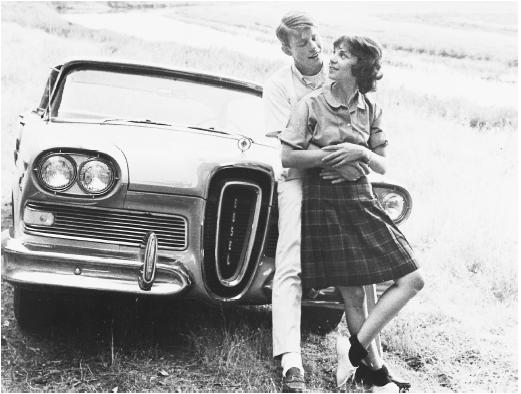American Graffiti - Film (Movie) Plot and Review
USA, 1972
Director: George Lucas
Production: A Universal-Lucasfilm Ltd.-Coppola Production; color, 35mm; running time: 110 minutes. Released 1973. Filmed 1972 in Petaluma and San Rafael, California; cost: about $700,000.
Producers: Francis Ford Coppola and Gary Kurtz; screenplay: George Lucas, Gloria Katz, and Willard Huyck, from an idea by George Lucas; photography: Ron Eveslage and Jan D'Alquen; editors: Verna Fields and Marcia Lucas; sound: Walter Murch; musical score comprised of original versions of several rock-and-roll "classics" from early 1960s.
Cast: Richard Dreyfuss ( Curt Henderson ); Ron Howard ( Steve Bolander ); Paul Le Mat ( John Milner ); Charles Martin Smith ( Terry Fields ); Cindy Williams ( Laurie Henderson ); Candy Clark ( Debbie ); Mackenzie Phillips ( Carol ); Suzanne Sommers ( Girl in T-Bird ); Wolfman Jack ( Disc jockey ); Harrison Ford ( Drag racer ).
Awards: New York Film Critics Award, Best Screenwriting, 1973; American Film Institute's "100 Years, 100 Movies," 1998.
Publications
Script:
Lucas, George, and others, American Graffiti: A Screenplay , New York, 1973.
Books:
Pollock, Dale, Skywalking: The Life and Films of George Lucas , New York, 1983.
Mabery, D.L., George Lucas , Minneapolis, 1987.
Champlin, Charles, George Lucas; The Creative Impulse: Lucasfilm's First Twenty Years , New York, 1997.
Kline, Sally, George Lucas; Interviews , Jackson, 1999.
White, Dana, George Lucas , Minneapolis, 1999.
Articles:
Dempsey, M., in Film Quarterly (Berkeley), Fall 1973.
Ney, J., in Interview (New York), September 1973.
New York Times , 7 October 1973.
Houston, Beverle, and Marsha Kinder, in Film Heritage (Dayton, Ohio), Winter 1973–74.
Combs, Richard, in Monthly Film Bulletin (London), February 1974.
Sturhahn, Larry, "The Filming of American Graffiti ," in Filmmakers' Newsletter (Ward Hill, Massachusetts), March 1974.
Dawson, Jan, in Sight and Sound (London), Spring 1974.
Farber, Steven, "George Lucas: The Stinky Kid Hits the Big Time," in Film Quarterly (Berkeley), Spring 1974.
Rosenthal, S., in Focus on Film (London), Spring 1974.
Warner, A., in Films and Filming (London), May 1974.
Segond, J., "Lettre de Londres," in Positif (Paris), September 1974.
Sodowsky, A., and others, "The Epic World of American Graffiti ," in Journal of Popular Culture (Bowling Green, Ohio), vol. 4, no. 1, 1975.
MacCabe, Colin, "Theory of Film: Principles of Realism and Pleasure," in Screen (London), no. 3, 1976.
"George Lucas," in Current Biography Yearbook , New York, 1978.
Fairchild, Jr., B. H., "Songs of Innocence and Experience: The Blakean Vision of George Lucas," in Literature/Film Quarterly (Salisbury, Maryland), no. 2, 1979.
Pye, M., and L. Myles, "The Man Who Made Star Wars ," in Atlantic Monthly (Boston), March 1979.
Prouty, Howard H., in Magill's Survey of Cinema 1 , Englewood Cliffs, New Jersey, 1980.
Harmetz, Aljean, "George Lucas—Burden of Dreams," in American Film (Washington, D.C.), June 1983.
Douin, Jean-Luc, "À toute berzingue," in Télérama (Paris), 26 May 1993.
Speed, Lesley, "Tuesday's Gone: The Nostalgic Teen Film," in Journal of Popular Film and Television (Washington, D.C.), vol. 26, no. 1, Spring 1998.
* * *
If Star Wars is George Lucas's idealized dream of the future, American Graffiti is his idealized dream of the past, a past in which optimism and naiveté were cherished sentiments before cynicism became a national past time. What joins these two films, however, is a devotion to entertainment, to the depiction of glorious worlds in which adventure is triumphant.

With the assistance of Francis Ford Coppola, Lucas's remembrance of teenage life in his home town of Modesto, California was brought to the screen, ushering in a wave of nostalgia for the music and lifestyle of an era ten years past, an era which subsequently became a staple of television situation comedies such as Happy Days and Laverne and Shirley , Ron Howard and Cindy Williams moving easily from this film to their television roles.
The central organizing device of this film is the musical score, permissions for which totalled $80,000 of the $700,000 budget. Music, which functions as the narrator of teen dreams and frustrations, as omnipresent companion, and as motivator of lifestyle, joins the various narrative threads and the three central locales: the hop where you danced to a band, the diner where you played the jukebox, and the strip where you listened to Spiritual Father Wolfman Jack on the car radio. To accentuate the overriding function of the music, Lucas strove for a visual quality which resembled the aura of a 1962 "Hot-Rods-to-Hell" jukebox. For many growing up is a musical experience and, along with Barry Levinson's Diner, American Graffiti is the best evocation of that idea.
The narrative of American Graffiti is that of a day in the life of four central male characters coming of age after indulging in a series of misadventures. Lucas located a mood of optimism and naiveté by setting the film in 1962, the period immediately prior to the Kennedy assassination and the resultant politicization of American youth and music. Naive optimism was so firmly entrenched that individuals refused to admit the necessity for personal development. Curt, whose avowed dream is to shake the hand of JFK, almost succumbs to the complacent notion of "why leave home to find a new home?" At the end of the film, after much indecisiveness, he does leave in pursuit of a future beyond the confines of family and home town. As such he is representative of those students of the sixties who overcame their innocence and ventured forth.
In Lucas's sentimental view of growing up, he lovingly portrayed the innocence and freedom of life-before-twenty and perhaps unwittingly, the seductive mythology of the teen dream. Audiences bought the dream overwhelmingly. American Graffiti grossed over $50 million in its first year, making it, to that point, the most successful film made for under $1 million. Its release in Japan helped foster a booming business there in American musical and fashion nostalgia.
—Doug Tomlinson
Comment about this article, ask questions, or add new information about this topic: